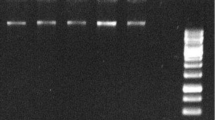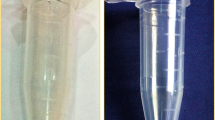Abstract
Isolation of high quality, high molecular weight RNA from plant tissues is complicated by high levels of polyphenols and polysaccharides which bind to and/or co-precipitate with RNA. Using high molecular weight polyethylene glycol (HMW-PEG), RNA was successfully isolated from plant species in which other RNA extraction methods and commercially available kits failed to deliver suitable results. We tested various buffer systems and isolation conditions with and without PEG or PVP (polyvinylpyrrolidone) using tissue from species ofAloe, Ananas, Clusia, Euphorbia, Kalanchoe, Opuntia, andPyrrosia, all of which contain high amounts of phenolic compounds and/or polysaccharides. HMW-PEG was found to be more effective than PVP in removing these compounds. RNA extraction using HMW-PEG resulted in RNA of high quality from all species investigated, as indicated by UV light absorption profiles, and also yielded PCR amplification products after reverse transcription.
Similar content being viewed by others
Abbreviations
- CAM:
-
crassulacean acid metabolism
- DEPC:
-
diethylpyrocarbonate
- EtBr:
-
ethidium bromide
- FW:
-
fresh weight
- GHCL:
-
guanidinium hydrochloride
- GITC:
-
guanidinium isothiocyanate
- HMW-PEG:
-
high-molecular-weight polyethylene glycol
- NaAc:
-
sodium-acetate
- PCI:
-
phenol/chloroform/isoamyl-alcohol-mix
- PVP:
-
polyvinylpyrrolidone
- RT:
-
room temperature
- RT-PCR:
-
reverse-transcription-polymerase chain reaction
- TRIR:
-
Trizol-reagent
- UV:
-
ultraviolet
References
Cathala G, Savouret JF, Mendez B, West BL, Karin M, Martial JA and Baxter JD (1983) A method for isolation of intact, translationally active ribonucleic acid. DNA 2: 329–335.
Chang S, Puryear J and Cairney J (1993) A simple and efficient method for isolating RNA from pine trees. Plant Mol Biol Reptr 11: 113–116.
Chirgwin JM, Pryzbyla AE, MacDonald RJ and Rutter WJ (1979) Isolation of biologically active ribonucleic acid from sources enriched in ribonuclease. Biochem 18: 5294–5299.
Chomczynski P and Sacchi N (1987) Single-step method of RNA isolation by acid guanidinium thiocyanate-phenol-chloroform extraction. Anal Biochem 162: 156–159.
Glisin V, Crkvenjakov R and Byus D (1974) Ribonucleic acid isolation by caesium chloride centrifugation. Biochem 13: 2633–2637.
Gruffat D (1998) Isolation of RNA from mammalian cells: application to large mRNA. In: Siebert PD and Larrick JW (eds), Gene cloning and analysis by RT-PCR. BioTechniques 23: 35–55.
Han JH, Stratowa C and Rutter WJ (1987) Isolation of full-length putative rat lysophospholipase cDNA using improved methods for mRNA isolation and cDNA cloning. Biochem 26: 1617–1625.
Loomis WD (1974) Overcoming problems of phenolic and quinones in the isolation of plant enzymes and organelles. Meth Enzymol 31: 528–545.
Salzman RA, Fujita T, Zhu-Salzman K, Hasegawa PM and Bressan RA (1999) An improved RNA isolation method for plant tissues containing high levels of phenolic compounds or carbohydrates. Plant Mol Biol Reptr 17: 11–17.
Sambrook J, Fritsch EF and Maniatis T (1989) Molecular Cloning: A Laboratory Manual. Cold Spring Harbor Laboratory Press, Cold Spring Harbour, New York, U.S.A.
Tesnier C and Vayda ME (1991) Method for isolation of high-quality RNA from grape berry tissues without contaminating tannins or carbohydrates. Plant Mol Biol Reptr 9: 242–251.
Woodhead M, Taylor MA, Davies HV, Brennan RM and McNicol RJ (1997) Isolation of RNA from blackcurrant (Ribes nigrum L.) fruit. Mol Biotechnol 7(1): 1–4.
Author information
Authors and Affiliations
Corresponding author
Rights and permissions
About this article
Cite this article
Gehrig, H.H., Winter, K., Cushman, J. et al. An improved RNA isolation method for succulent plant species rich in polyphenols and polysaccharides. Plant Mol Biol Rep 18, 369–376 (2000). https://doi.org/10.1007/BF02825065
Published:
Issue Date:
DOI: https://doi.org/10.1007/BF02825065




